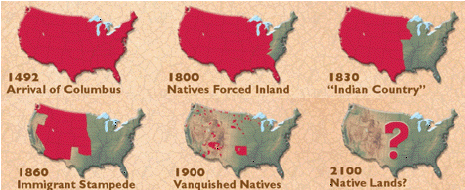
|
||||||||||||
|
|
|
Native Americans Native Americans in the United States are the indigenous peoples from the regions of North America now encompassed by the continental United States, including parts of Alaska. They comprise a large number of distinct tribes, states, and ethnic groups, many of which are still enduring as political communities. There is a wide range of terms used, and some controversy surrounding their use: they are variously known as American Indians, Indians, Amerindians, Amerinds, or Indigenous, Aboriginal or Original Americans.
William Penn's Treaty with the Indians when he founded the Province of Pennsylvania in North America, 1771 Pennsylvania Academy of the Fine Arts, Philadelphia The European colonization of the Americas nearly obliterated the populations and cultures of the Native Americans. During the 16th through 19th centuries, their populations were ravaged by conflicts with European explorers and colonists, disease, displacement, enslavement, internal warfare as well as high rate of intermarriage. Scholars now believe that, among the various contributing factors, epidemic disease was the overwhelming cause of the population decline of the American natives. In the nineteenth century, the Westward expansion of the United States compelled large numbers of Native Americans to resettle further west, often by force, almost always reluctantly. Under President Andrew Jackson, Congress passed the Indian Removal Act of 1830, which authorized the President to conduct treaties to exchange Native American land east of the Mississippi River for lands west of the river. As many as 100,000 Native Americans eventually relocated in the West as a result of this Indian Removal policy.
Conflicts, generally known as "Indian Wars", broke out between U.S. forces and many different tribes. U.S. government authorities entered numerous treaties during this period, but later abrogated many for various reasons. Well-known military engagements include the Native American victory at the Battle of Little Bighorn in 1876 and the massacre of Native Americans at Wounded Knee in 1890. This, together with the near-extinction of the American Bison that many tribes had lived on, set about the downturn of Prairie Culture that had developed around the use of the horse for hunting, travel and trading. By conservative estimates, the Native American population of the United states prior to European contact was greater than 12 million. According to 2003 United States Census Bureau estimates, a little over one third of the 2,786,652 Native Americans in the United States live in three states: California at 413,382, Arizona at 294,137 and Oklahoma at 279,559. Today there are 561 federally recognized tribal governments in the United States. These tribes possess the right to form their own government, to enforce laws (both civil and criminal), to tax, to establish membership, to license and regulate activities, to zone and to exclude persons from tribal territories. Limitations on tribal powers of self-government include the same limitations applicable to states; for example, neither tribes nor states have the power to make war, engage in foreign relations, or coin money. The largest tribes in the U.S. by population are Navajo, Cherokee, Choctaw, Sioux, Chippewa, Apache, Lumbee, Blackfeet, Iroquois, and Pueblo. Indian Reservations
http://www.nps.gov/nagpra/DOCUMENTS/RESERV.PDF An Indian reservation is an area of land managed by a Native American tribe under the United States Department of the Interior's Bureau of Indian Affairs. There are about 310 Indian reservations in the United States, meaning not all of the country's 550-plus recognized tribes have a reservation — some tribes have more than one reservation, some share reservations, while others have none.The collective geographical area of all reservations is 55.7 million acres (225,410 km²), representing 2.3% of the area of the United States (2,379,400,204 acres; 9,629,091 km²). Twelve Indian reservations are larger than the state of Rhode Island (776,960 acres; 3,144 km²) and nine reservations larger than Delaware (1,316,480 acres; 5,327 km²). The territory of the Navajo Nation compares in size to West Virginia. Reservations are unevenly distributed throughout the country; the majority are west of the Mississippi River and occupy lands that were first reserved by treaty or 'granted' from the public domain |







